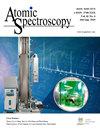In Situ Rb-Sr Dating Of Lunar Meteorites Using Laser Ablation MC-ICP-MS
IF 2.3
2区 化学
Q1 SPECTROSCOPY
引用次数: 5
Abstract
: Plagioclase, pyroxene and glass are the main component phases of different planetary materials. In situ Rb-Sr dating of these common phases thus would represent the timing of magmatic differentiation, effectively complementary to the rare, tiny U-Pb bearing phases that only form at a late stage. In this study, we selected lunar meteorites as examples to establish an i n situ Rb-Sr dating method where plagioclase, pyroxene, ilmenite, and glasses were the laser-ablation (LA) targets. The accuracy of 87 Sr/ 86 Sr and 87 Rb/ 86 Sr measured by LA-MC-ICP-MS was better than 0.2 ‰ and 3 %, respectively, for samples with an 87 Rb/ 86 Sr ratio lower than 1. However, we found that the distributions of Rb and Sr in the natural materials were heterogeneous at the micrometer scale, leading to inaccurate 87 Rb/ 86 Sr ratio correction when calculated by normal data reduction methods. A new data reduction strategy of the smallest unit of isochron age (SUIA) was developed. Using the SUIA, the Rb-Sr isochron age of 2984 ± 43 Ma and 3149 ± 20 Ma was obtained for two lunar meteorites (NWA 10597 and NWA 6950, respectively). These results are identical within 1-2% deviation relative to the U-Pb dating ages for baddeleyite and apatite using SIMS. The present method may have broad applicability for determining the Rb-Sr isochron ages of other planetary samples.月球陨石激光烧蚀MC-ICP-MS原位Rb-Sr测年
斜长石、辉石和玻璃是不同行星材料的主要组成相。因此,这些共同阶段的原位Rb-Sr定年将代表岩浆分异的时间,有效地补充了只在后期形成的罕见的微小含U-Pb阶段。在这项研究中,我们以月球陨石为例,建立了一种原位Rb-Sr测年方法,其中斜长石、辉石、钛铁矿和玻璃是激光烧蚀(LA)的目标。对于87 Rb/ 86 Sr比小于1的样品,LA-MC-ICP-MS测定87 Sr/ 86 Sr和87 Rb/ 86 Sr的准确度分别优于0.2‰和3%。然而,我们发现天然材料中的Rb和Sr在微米尺度上的分布是不均匀的,这导致用常规数据约简方法计算87 Rb/ 86 Sr比时不准确。提出了一种新的等时年龄最小单位(SUIA)数据约简策略。利用SUIA对两块月球陨石(NWA 10597和NWA 6950)的Rb-Sr等时线年龄分别为2984±43 Ma和3149±20 Ma。这些结果与使用SIMS对坏辉石和磷灰石的U-Pb定年年龄在1-2%的偏差范围内相同。本方法对其它行星样品的Rb-Sr等时年龄的测定具有广泛的适用性。
本文章由计算机程序翻译,如有差异,请以英文原文为准。
求助全文
约1分钟内获得全文
求助全文
来源期刊

Atomic Spectroscopy
物理-光谱学
CiteScore
5.30
自引率
14.70%
发文量
42
审稿时长
4.5 months
期刊介绍:
The ATOMIC SPECTROSCOPY is a peer-reviewed international journal started in 1962 by Dr. Walter Slavin and now is published by Atomic Spectroscopy Press Limited (ASPL). It is intended for the rapid publication of both original articles and review articles in the fields of AAS, AFS, ICP-OES, ICP-MS, GD-MS, TIMS, SIMS, AMS, LIBS, XRF and related techniques. Manuscripts dealing with (i) instrumentation & fundamentals, (ii) methodology development & applications, and (iii) standard reference materials (SRMs) development can be submitted for publication.
 求助内容:
求助内容: 应助结果提醒方式:
应助结果提醒方式:


